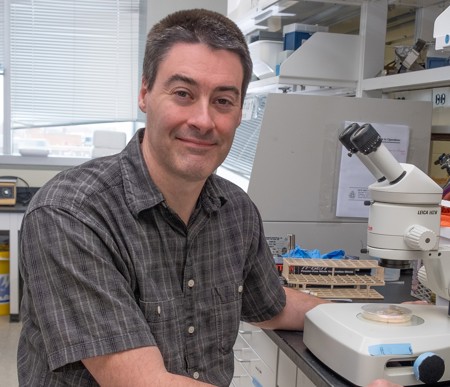Christopher M Waters
Professor, Department of Microbiology, Genetics, & Immunology
Faculty, Genetics & Genome Sciences Program
Faculty, Cell & Molecular Biology Program
Professor, BioMolecular Science Gateway
Location: 5180 Biomed Phys Sci
Phone: 517-884-5360
Email: watersc3@msu.edu
Expertise:
Bio
###Education B.S., 1997, University of Kansas Ph.D., 2002, University of Minnesota Post-doctoral studies, 2003-2008, Princeton University ###Research Bacteria utilize chemical signals to adapt to an ever-changing environment. In bacterial pathogens, chemical signaling plays an important role in the initiation, maintenance, and termination of infection. My laboratory studies chemical signaling in the human pathogen Vibrio cholerae to further understand the role these chemical signals play in bacterial pathogenesis. Additionally, we are developing new strategies that disrupt chemical signaling pathways to control bacterial disease. One research focus of my laboratory is the bacterial second messenger molecule cyclic di-GMP (c-di-GMP). C-di-GMP regulates both biofilm formation and virulence factor expression in many bacterial pathogens including V. cholerae. Synthesis of c-di-GMP occurs via enzymes encoding GGDEF domains while degradation occurs via enzymes encoding EAL or HD-GYP domains. Astonishingly, V. cholerae has over 60 proteins encoding one of these domains! Based on domain analysis of these enzymes, we predict that each responds to a unique cue that regulates its enzymatic activity. One research area in my laboratory is to identify a subset of these cues and determine how they modulate the intracellular levels of c-di-GMP. In addition, the degree of signaling specificity in c-di-GMP pathways remains unclear due to the large number of synthesis/degradation enzymes controlling a common, diffusible signal . Efforts are currently underway to determine the signaling specificity of GGDEF- and EAL-encoded proteins in V. cholerae. Finally, c-di-GMP presents a new target for the development of anti-microbial strategies because it controls both biofilm formation and virulence factor expression in numerous bacterial pathogens. My laboratory is interested in identifying novel chemical compounds that interfere with c-di-GMP signaling as potential therapeutics for bacterial disease. Quorum sensing is another chemical signaling system in V. cholerae that functions via the secretion and detection of chemical signals known as autoinducers (AIs). Because bacteria continually secrete AIs, the concentration of AIs in the environment increases proportionally to the density of the population, enabling the bacteria to regulate genes in a density dependent fashion. Analogous to c-di-GMP, quorum sensing controls the expression of numerous genes including those responsible for biofilm formation and virulence. Recently, we have shown that quorum sensing and c-di-GMP converge to control biofilm formation in V. cholerae. Another area of research in my laboratory is to further understand the individual roles and interconnection of these two chemical signaling systems in the disease life cycle of V. cholerae. ###Links * [Google Scholar](https://scholar.google.com/citations?hl=en&user=cFDKqAsAAAAJ) * [Twitter](http://twitter.com/@WatersLabMSU)
Courses
- MGI 499: Undergraduate Research
